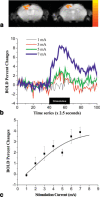Echo-planar BOLD fMRI of mice on a narrow-bore 9.4 T magnet
- PMID: 15282829
- PMCID: PMC2949950
- DOI: 10.1002/mrm.20158
Echo-planar BOLD fMRI of mice on a narrow-bore 9.4 T magnet
Abstract
The feasibility of BOLD fMRI in association with electrical somatosensory stimulation on spontaneously breathing, isoflurane-anesthetized mice was investigated using spin-echo, echo-planar imaging (EPI) on a vertical narrow-bore 9.4 T magnet. Three experiments were performed to derive an optimal fMRI protocol. In Experiment 1 (n = 9), spin-echo BOLD responses to 10% CO2 challenge under graded isoflurane (0.25-1.25%) ranged from 10 +/- 2% to 3.5 +/- 0.9%; the optimal BOLD contrast-to-noise ratio peaked at 0.75% isoflurane. In Experiment 2 (n = 6), hindpaw somatosensory stimulations using 1-7 mA under 0.75% isoflurane revealed the optimal BOLD response was at 6 mA. In Experiment 3 (n = 5), BOLD responses to 4 and 6 mA stimulation under 0.75% and 1% isoflurane were evaluated in detail, confirming the optimal conditions in Experiment 2. These results demonstrated that BOLD fMRI using single-shot, spin-echo EPI in a mouse somatosensory stimulation model could be routinely performed on high-field, vertical, narrow-bore magnets. This protocol might prove useful for fMRI studies of transgenic mice.
Figures



References
-
- Lee S-P, Silva AC, Ugurbil K, Kim S-G. Diffusion-weighted spin-echo fMRI at 9.4 T: microvascular/tissue contribution to BOLD signal change. Magn Reson Med. 1999;42:919–928. - PubMed
-
- Duong TQ, Yacoub E, Adriany G, Hu X, Merkle H, Andersen P, Vaughan JT, Ugurbil K, Kim S-G. Microvascular BOLD contribution at 4 and 7 T in the human brain: gradient-echo and spin-echo fMRI with suppression of blood effects. Magn Reson Med. 2003;49:1019–1027. - PubMed
-
- Duong TQ, Yacoub E, Adriany G, Hu X, Ugurbil K, Vaughan JT, Kim S-G. High-resolution, spin-echo BOLD and CBF fMRI: single-shot, slab-selective EPI. Magn Reson Med. 2002;48:589–593. - PubMed
-
- Mandeville JB, Marota JJ, Kosofsky BE, Keltner JR, Weissleder R, Rosen BR, Weisskoff RM. Dynamic functional imaging of relative cerebral blood volume during rat forepaw stimulation. Magn Reson Med. 1998;39:615–624. - PubMed
MeSH terms
Substances
Grants and funding
LinkOut - more resources
Full Text Sources

